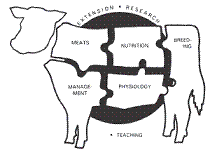Animal Science, Department of

Nebraska Beef Cattle Reports
Date of this Version
2023
Citation
2023 Nebraska Beef Cattle Report
UNL Beef, Institute of Agriculture and Natural Resources, University of Nebraska-Lincoln
Abstract
Methane emissions from growing and finishing calves born into a spring calving, conventional cow system or a summer calving, partially-confined cow system were compared. Cows fed a restricted diet of corn-byproduct and grain residues in confinement produced less methane and carbon dioxide per day compared to cows grazing pasture or cover crop. Calves weaned from the confinement-based production system were smaller at weaning and compensated with greater gain during the growing phase. More days on feed in the finishing phase were needed for the calves from the confinement system to reach same backfat thickness. Over the entire growing and finishing phases, calves from the confinement-based system produced more total methane and methane per lb of carcass weight. Carbon sequestered into brome pasture and oat forage biomass was measured. Total measured emissions from all stages of beef production were combined with modeled emissions from soil and manure. Conventional cow-calf production grazing perennial cool season grasses sequestered enough carbon to offset 138% of all carbon emissions from gestation, lactation, growing and finishing stages. Annual forages grazed in the partial confinement system offset 70% of total emissions from the system. Minimizing emissions and maximizing sequestration can make beef production climate neutral or better, depending on management practices used.
Included in
Large or Food Animal and Equine Medicine Commons, Meat Science Commons, Veterinary Preventive Medicine, Epidemiology, and Public Health Commons

